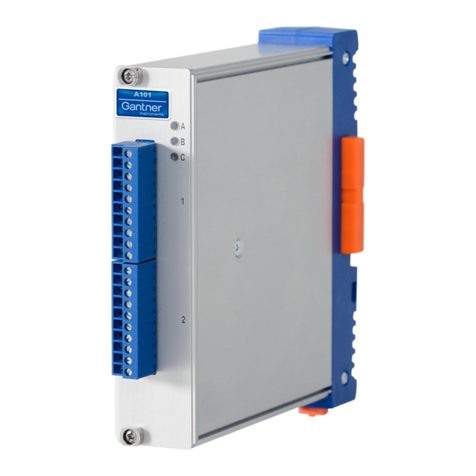
e.bloxx D1-1, D1-4
TABLE OF CONTENTS
5
HB_EBLOXX-D1_E_V18.doc
Gantner Instruments Test & Measurement GmbH
TABLE OF CONTENTS
1.
ABOUT THIS MANUAL
.....................................................................................................................................7
2.
MODULE DESCRIPTION
...................................................................................................................................8
2.1.
System Overview
..................................................................................................................................................8
2.2.
Types of Modules
..................................................................................................................................................9
2.3.
Module Parts
.......................................................................................................................................................10
2.4.
Functional Overview
............................................................................................................................................11
2.5.
Front-LED
...........................................................................................................................................................11
2.6.
DC-Isolation
........................................................................................................................................................11
2.7.
Functional Diagram
.............................................................................................................................................12
3.
MOUNTING E.BLOXX AND CONNECTING WIRES
...........................................................................................13
3.1.
Environmental Conditions
.....................................................................................................................................13
3.2.
Connection Technique
.........................................................................................................................................13
3.3.
Power Supply
......................................................................................................................................................13
3.4.
Bus Connection
...................................................................................................................................................14
3.5.
Shielding
.............................................................................................................................................................19
3.6.
Rapid Bus Link Plug
............................................................................................................................................19
4.
MEASUREMENTS
..........................................................................................................................................21
4.1.
General
..............................................................................................................................................................21
4.2.
Variations - Specifications:
...................................................................................................................................22
4.3.
Digital Input - Status Recording
............................................................................................................................23
4.4.
Digital Input - Frequency Measurement
.................................................................................................................23
4.5.
Digital Input - Frequency Measurement Chronos Method
........................................................................................24
4.6.
Digital Input - Frequency Measurement Fast Chronos Method
.................................................................................25
4.7.
Digital Input - Progressive Counter (Up-Counter)
....................................................................................................26
4.8
Digital Input - Up/Down Counter
............................................................................................................................26
4.9.
Digital Input - Quadrature Counter
........................................................................................................................27
4.10.
Digital Status Output - Host-Controlled
..................................................................................................................28
4.11.
Digital Status Output - Process-Controlled
.............................................................................................................29
4.12.
Digital Status Output - Pulse-Width Modulated Signal Output (PWM)
.......................................................................29
5.
CONFIGURATION
...........................................................................................................................................31
5.1.
General Information about Configuration Software ICP 100
.....................................................................................31
5.2.
Setting Address and Baud Rate of an e.bloxx
........................................................................................................31
5.3.
e.bloxx Settings
...................................................................................................................................................32
5.4.
Definition of Channels
..........................................................................................................................................33
6.
SPECIFICATIONS
...........................................................................................................................................34
6.1.
Digital Inputs
.......................................................................................................................................................34
6.2.
Digital Outputs
....................................................................................................................................................34
6.3.
Communication Interface
.....................................................................................................................................34
6.4.
Firmware Types in Scope of Supply
......................................................................................................................35
6.5.
Power Supply
......................................................................................................................................................35
6.6.
Mechanical
.........................................................................................................................................................36
6.7.
Connection
.........................................................................................................................................................36
6.8.
Environmental Conditions
.....................................................................................................................................36
7.
DECLERATION OF CONFIRMATION
...............................................................................................................37





























